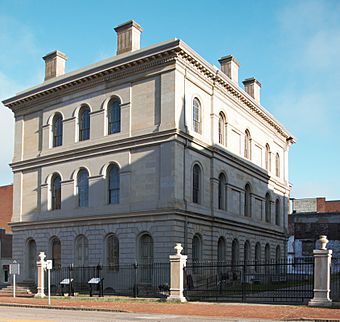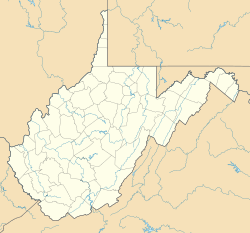West Virginia Independence Hall facts for kids
|
West Virginia Independence Hall
|
|
 |
|
| Location | 1528 Market St., Wheeling, West Virginia |
|---|---|
| Built | 1859 |
| Architect | Ammi B. Young; Alfred B. Mullett |
| Architectural style | Renaissance |
| NRHP reference No. | 70000660 |
Quick facts for kids Significant dates |
|
| Added to NRHP | January 26, 1970 |
| Designated NHL | June 20, 1988 |
West Virginia Independence Hall is a very important historic building in Wheeling, West Virginia. It was built in 1860. The architect Ammi B. Young oversaw its construction. This building was first used by the United States government. It served as a custom house, a post office, and a courthouse.
The building is special because of its design. It used new ways of building with strong metal called wrought iron. It is also very important in history. It played a big part in the American Civil War. Important meetings happened here, like the Wheeling Convention in 1861. These meetings led to West Virginia becoming a separate state. West Virginia broke away from Virginia, which had joined the Confederacy. This made West Virginia the only state to separate from a Confederate state during the war.
From 1861 to 1863, this building was the center of the "Restored Government of Virginia." This was the part of Virginia that stayed loyal to the Union. Francis Harrison Pierpont was its governor. In 1988, the building was named a National Historic Landmark. Today, it is a museum run by the state. It shows exhibits about West Virginia's history.
Contents
Building Design and Features
West Virginia Independence Hall is in downtown Wheeling. It is located near the Ohio River. The building has three stories. It is made of strong stone blocks called sandstone. Its style is called Renaissance Revival. This means it looks like buildings from the Renaissance period.
You can see round-arch windows and doors. The main entrance has a series of arches. The first floor has deep, rough stone joints. There are also decorative bands between each floor. At the top, there is a fancy ledge with small blocks.
Inside the Hall
The inside of the building also has round-arch doorways. A special feature inside is its strong metal frame. This frame uses rolled I-beams made of wrought iron. These I-beams were very new at the time. This building is one of the first to use them. Its metal frame is a great example of early wrought iron construction.
Changes Over Time
The building has been changed many times. But many changes have been undone. This was done to make the building look like its original design. The first architect, Ammi B. Young, designed a flat roof. This roof did not drain water well. So, in the late 1860s, a steeper roof was added. This new design was by Alfred B. Mullett.
Later, a fourth floor was added to the building. This extra floor was removed during a restoration project. However, the steeper roof designed by Mullett was kept.
A Place in History
The United States government built this hall in 1859. It had several important jobs. Wheeling was a busy port on the Ohio River. So, it needed a custom house to handle goods. The building also housed a federal court and the post office.
From 1860 to 1907, it was a federal courthouse. It served different federal courts over the years. These included the courts for the Western District of Virginia and later for West Virginia.
The Civil War and a New State
When the American Civil War began in 1861, many people in northwestern Virginia did not agree with Virginia leaving the Union. While other federal buildings were taken over, the Wheeling custom house was not. It became a place for those who wanted to stay with the Union.
The Wheeling Convention in May 1861 happened here. At this meeting, people first talked about separating from Virginia. This part of Virginia had strong ties to the Union states nearby. A second, smaller meeting in June 1861 also took place here. This meeting created the "Restored Government of Virginia." The United States government recognized this as the true government of Virginia during the war. This government stayed in the building until 1863.
The meeting that wrote West Virginia's first constitution also happened here. The building was even used as a place to store weapons for the West Virginia militia.
Later Years and Restoration
In 1907, the federal government built a new building. They sold West Virginia Independence Hall. A company called Conservative Life Insurance Company bought most of it. They added a three-story section and the fourth floor.
In 1963, West Virginia celebrated its 100th birthday. The state bought the building. In 1969, money was set aside to restore it. The goal was to make it look like it did during the Civil War.
See also



